Orangery ideas – how to add an ultra-chic addition that will be the new heart of your home
Everything you need to know about orangery ideas, from interior design to practical insights from the experts, including planning permission and build costs...

As our homes have increasingly become a multi-functional sanctuary, orangery ideas are more popular than ever. They offer the opportunity to increase square footage with a sophisticated addition of space that can work as everything from kitchens, dining rooms, and living rooms, or all three put together.
And, while a classic orangery looks fabulous on a country property, you don't need to own a palatial pad to add this contemporary feature to your home.
'An orangery is an excellent opportunity to create extra living space within a home,' says Louise Wicksteed, Design Director for Sims Hilditch. 'The large windows break down the barrier between the inside and the outdoor space, creating an open and airy feel. Orangeries can equally be welcome additions to large, traditional homes, or smaller townhouses.'
Karen Bell, Creative Director at David Salisbury, says: 'A bespoke orangery can be designed to any style of property – a skilled designer will usually take inspiration from the architect of the existing home and design an extension that will complement its surroundings.'
Before embarking on an orangery extension, there are a number of factors to consider, including whether you will need planning permission (highly likely), how much an orangery will cost to add, and the difference between an orangery and a conservatory.
We've tapped the experts to answer all of your orangery questions below and well as some gorgeous extension ideas so you can be well-prepared when planning this special addition to any home.
What is an orangery?
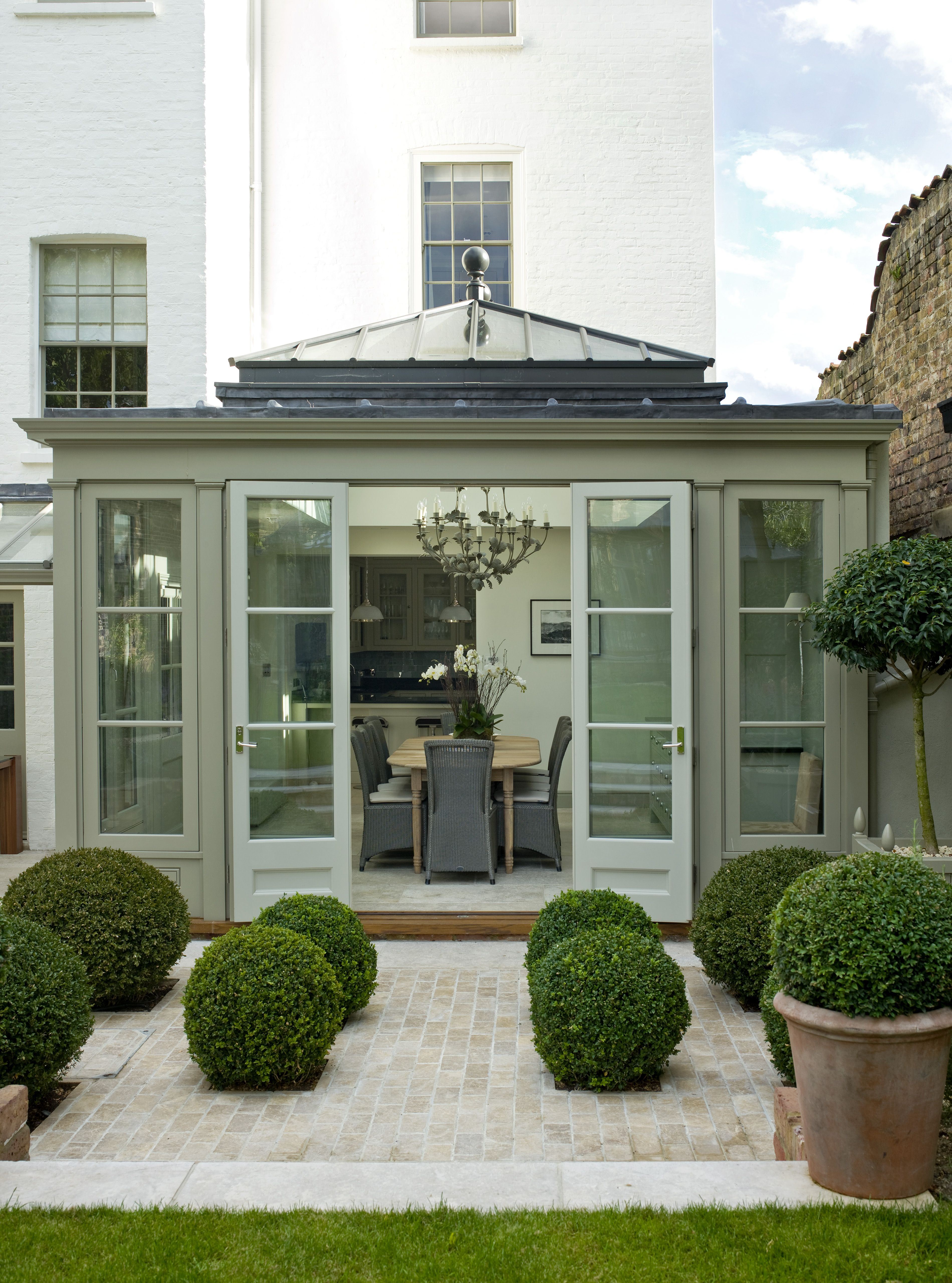
'An orangery is a type of glazed extension, which typically features a perimeter flat roof area with one or more lantern roofs allowing in overhead natural light,' explains Karen Bell, Creative Director, David Salisbury.
The Livingetc newsletters are your inside source for what’s shaping interiors now - and what’s next. Discover trend forecasts, smart style ideas, and curated shopping inspiration that brings design to life. Subscribe today and stay ahead of the curve.
'For discerning homeowners, this type of extension has been more popular in recent years due to its versatility – an orangery provides multi-functional living space, that can work equally as well as an orangery kitchen extension or living room, whilst connecting your home and garden.'
Orangery ideas are a stunning addition to any home and, whilst their use may have changed over time, their distinguishing features never fail to deliver the wow factor.
'Orangeries date back to the 17th century Renaissance gardens of Italy, a period when glass production was becoming increasingly popular,' says James Upton, Managing Director of Westbury Garden Rooms.
'Orangeries were once a symbol of prestige and wealth, built on to the residences of the very wealthy in a bid to protect their fruit trees during the colder months. Residences would then provide these homegrown fruits to guests at dinner parties, when these items may well have been scarce for less wealthy people.'
He continues: 'Though their sense of luxury remains, the function of such spaces has changed considerably since the 17th century. Whilst some are still used for their original purpose, most residential orangeries are built to provide a fantastic setting for living or dining in.
'The combination of timber, glass, and masonry gives a sense of grandeur and the glazed roof lantern built into a flat roof is a real showpiece, providing unparalleled natural light and sky views.'
Orangery ideas for a stylish addition of space to your home
1. Create a modern farmhouse-style orangery kitchen extension
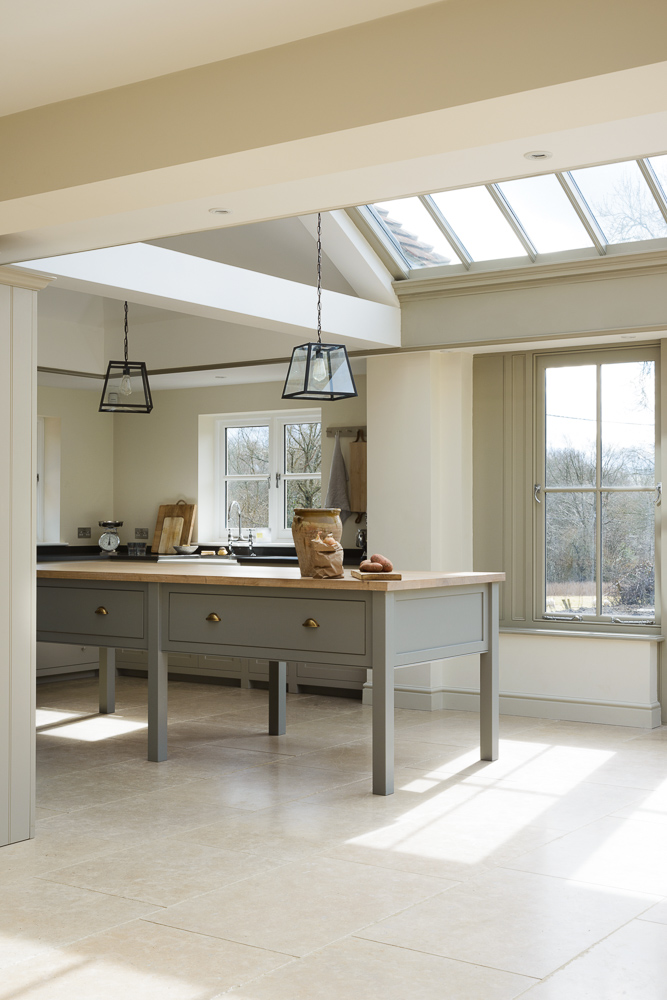
This beautiful space by deVOL shows how you can create an orangery kitchen extension that adds style and space to your home. The neutral tones, natural limestone floor, and rustic ceramics add warmth and character to the space, while industrial matte black pendants inject a modern edge to the room.
'Despite looking quite traditional, this orangery was brand new,' says deVOL. 'The key to this type of extension is that it’s not as glass-heavy as a conservatory, it tends to be a brick structure with large windows and a glass roof. They've been popular since the 17th century and so feel quite at home on the back of older buildings.
'Between the 17th and 19th centuries, orangeries were traditionally a room dedicated to protecting orange and other fruit trees from the freezing cold winters, fast forward to today and these customers chose to fill theirs with our humble handmade cupboards. What a triumph.'
2. Relax in a cozy yet chic TV room

Channel a modern country style in an ultra-cozy orangery living room. This beautiful space from Unique Homestays shows how a neutral backdrop is the perfect anchor to add rustic elements, including a log stack surround, checked throws, striped cushions, and a reclaimed wood coffee table.
The bright space also works the indoor/outdoor theme by introducing oversized plants into the interior while the glass windows and roof panels allow expansive views of the garden to flood the room.
3. Make a refined and elegant orangery dining space
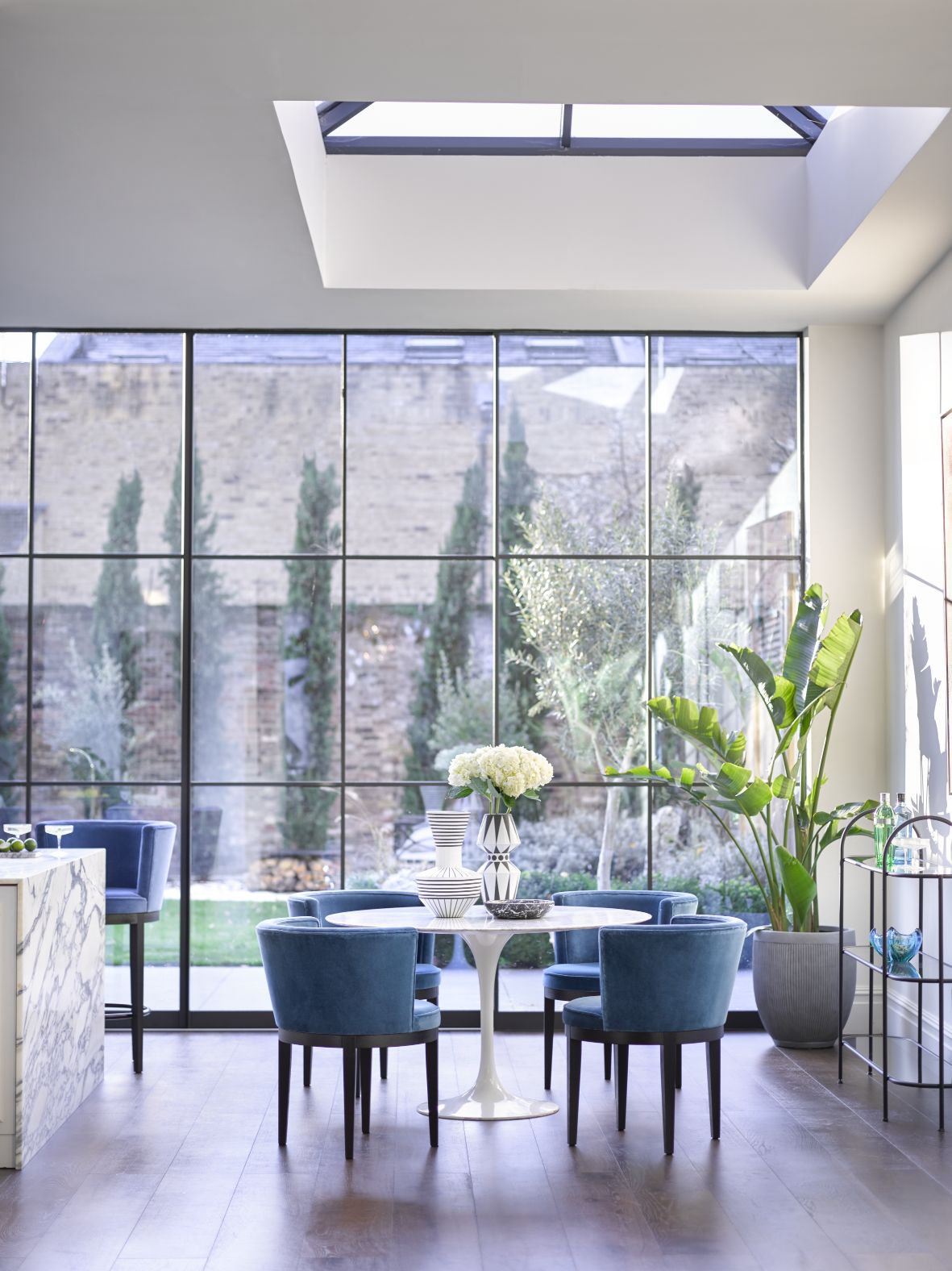
You can fashion a fabulous socialising space in an orangery extension, perfect for entertaining guests or simply for family dinners.
'These days, an orangery is a fashionable addition to a home, but tend to be used as an additional room for a property (as opposed to protecting orange and other fruit trees during winter),' says Nick Cryer, of Berkeley Place. 'Unlike conservatories, which are usually too cold in winter and too hot in summer, they tend to incorporate a more solid structure so they are far more useable all year round.'
4. Use statement lighting for a cool, contemporary vibe
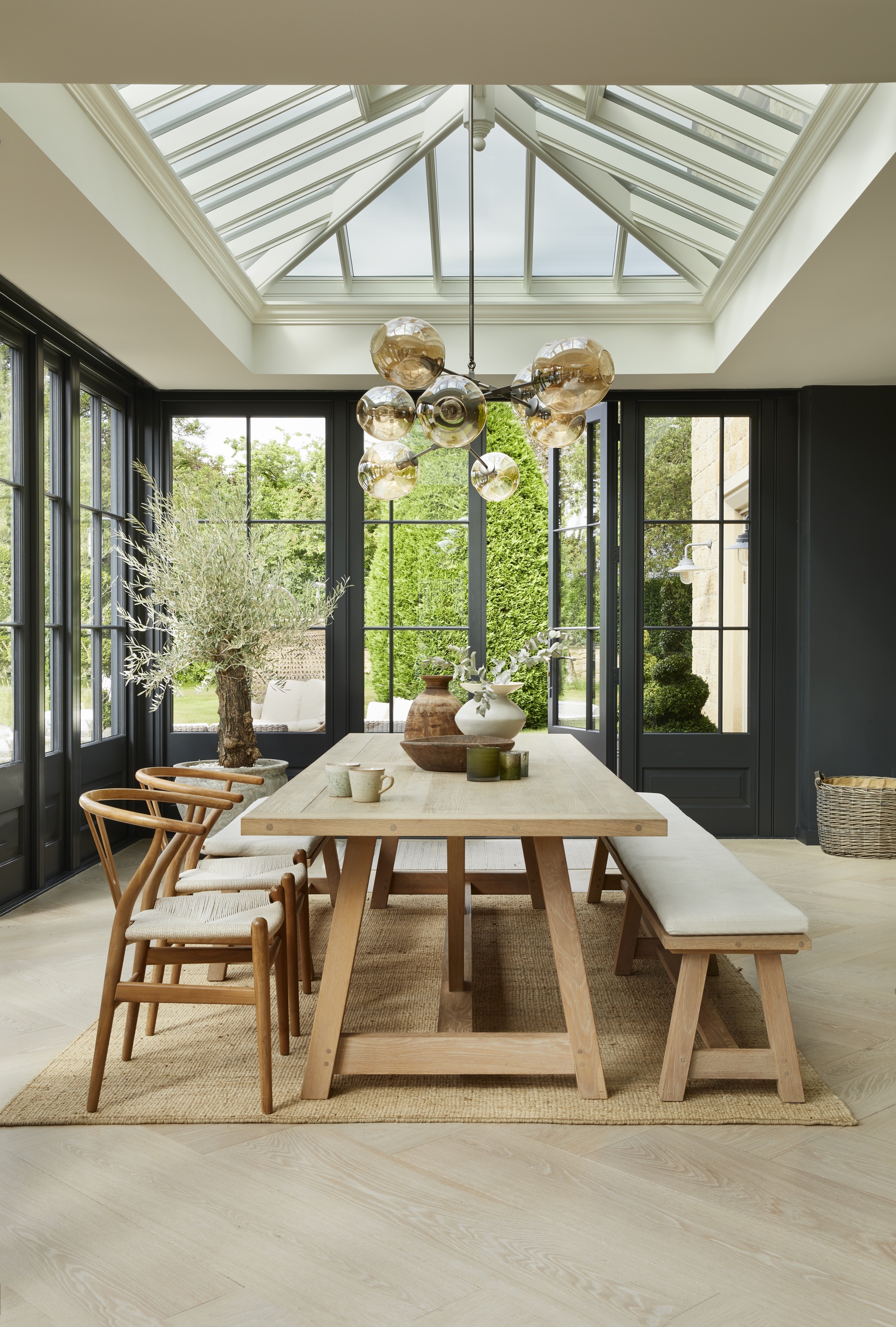
This beautiful orangery, with its bleached-out flooring and modern-industrial charcoal-hued framing, is given extra gravitas with an oversized, unique pendant lighting.
Hanging over the stunning dining space, a glass-blown geometric statement pendant light creates a talking-point focal piece and injects a creative, contemporary slant to the upscale decor.
5. Consider the exterior – country chic or contemporary cool?
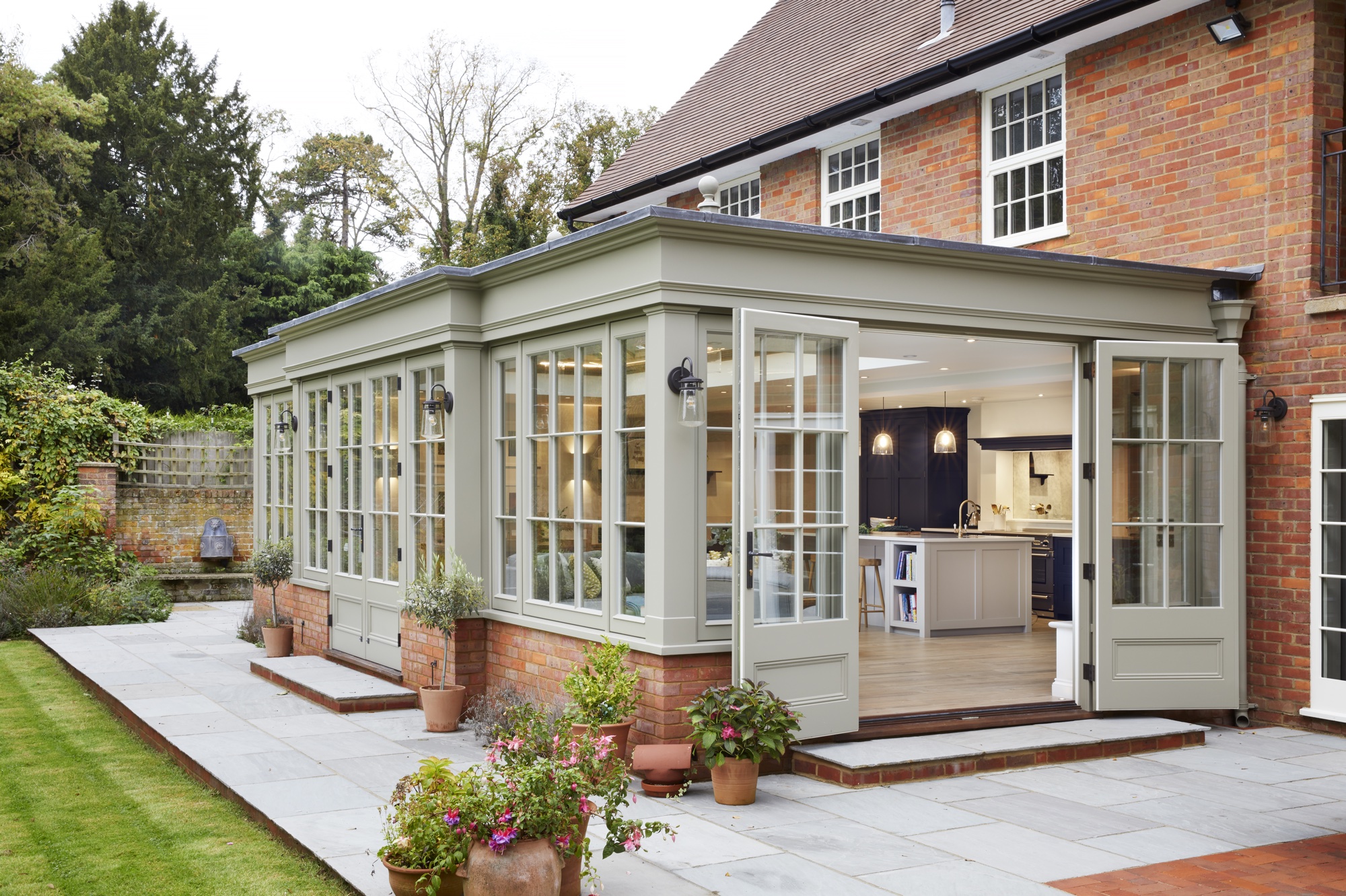
'When it comes to designing the exterior of a new orangery, an experienced designer will use a number of cues to influence the design of the extension, usually starting with the architecture of the existing property,' says Karen Bell, of David Salisbury.
Five key areas to consider, to ensure a design complements the host building are: Roof design; paint colour; window and door ideas (to echo the main building); matching brickwork; surrounding landscaping.
Karen continues: 'In terms of colors, we have seen an increase in darker greys (Halcyon Grey from our color palette, in particular), for those wanting a more contemporary finish – but we are also starting to see an increase in soothing country-style blue/green tones, in line with the increasing trend to use this color palette internally and in interior design.'
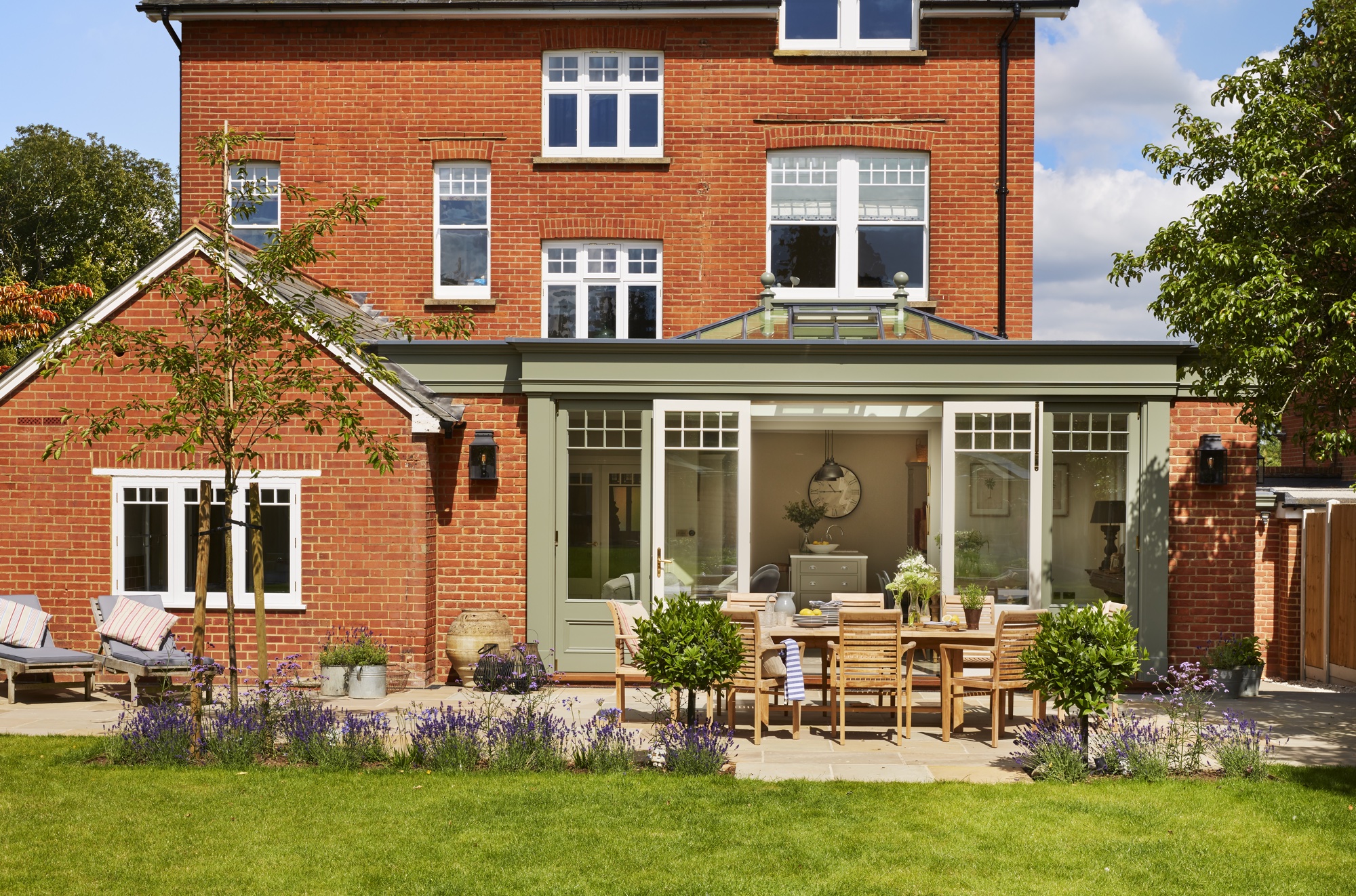
The above orangery is a lovely example of a contemporary-country exterior created by Jayne @emilycocointeriors and Westbury Garden Rooms, with the paintwork finished in Grey Green by M&L Paints.
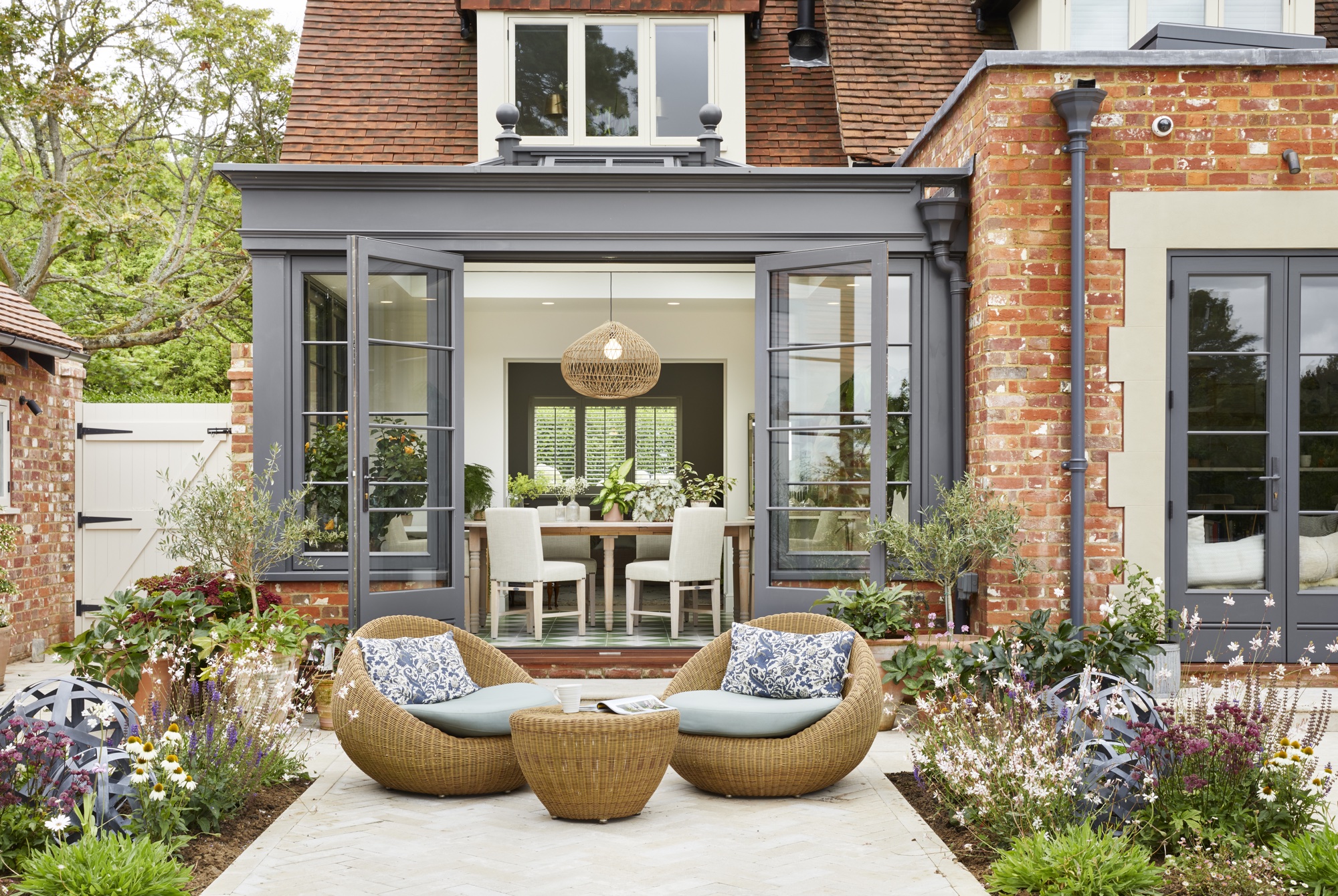
And James Upton adds: 'We love the use of bold colors both for internal furnishings and also for the joinery itself. More and more we see clients opt for darker colors of joinery such as Westbury Grey and Westbury Black, these colours make a real statement on the back of the home.'
6. Create a contemporary addition to a period property
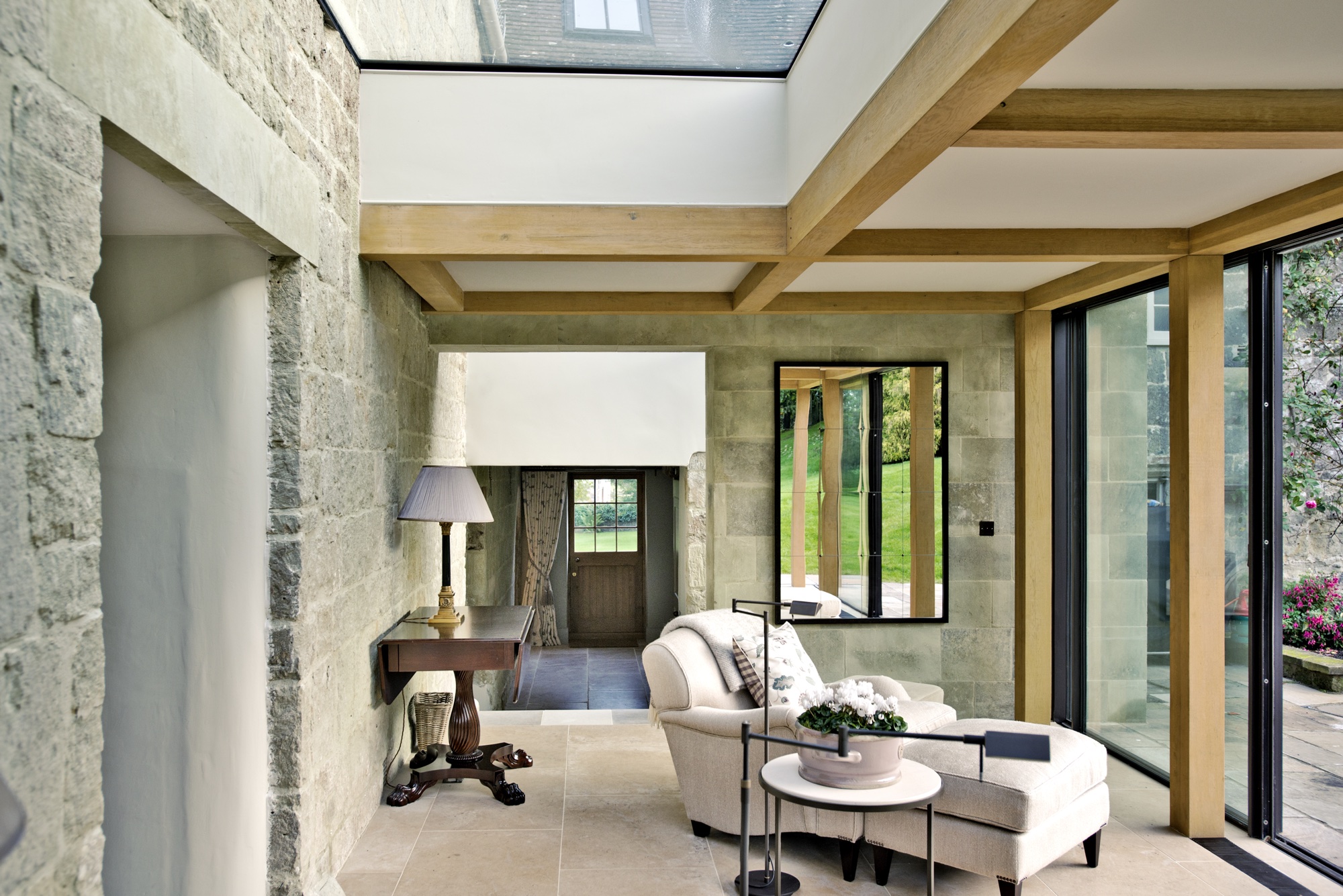
'Orangeries can be welcome additions to older, more traditional homes,' says Louise Wicksteed, Design Director for Sims Hilditch interior design.
'The sharp lines of the design used for our Dorset Manor house (above) has a slightly contemporary feel, which sits in nice contrast with the original stone used in the main structure of the house. To maintain a feeling of flow, we made a concerted effort to adhere to the palette of warm beiges, natural wools and linens that was used in the rest of the house.'
7. Decorate your orangery as you would the rest of your house
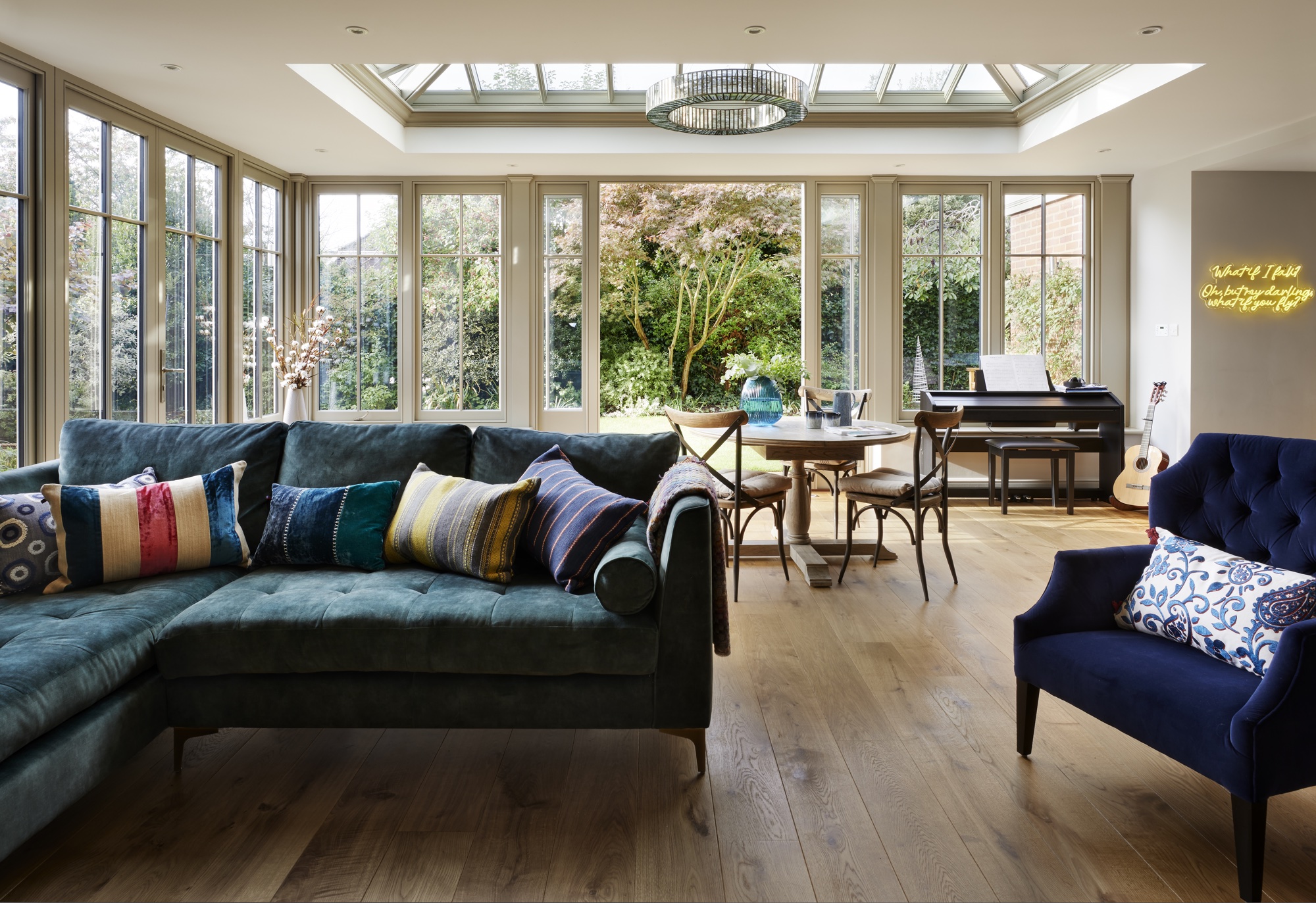
Don't forget: this is not an 80s conservatory tacked onto the back of the house. An orangery is a sumptuous space that should be treated with the same finesse as the rest of your interiors; after all, it is likely to become the most integral part of your home.
'Gone are the days of having to choose rattan furniture,' says James Upton. 'All of our clients choose to fully furnish their orangeries with the same style of furniture used for the rest of the home. We often see grand dining tables, corner sofas and complete luxury interior design schemes.'
We love how the decadent yet inviting velvet sofa and neon wall sign add character and style to this open plan extension.
8. Introduce grandiose accessories into a small orangery
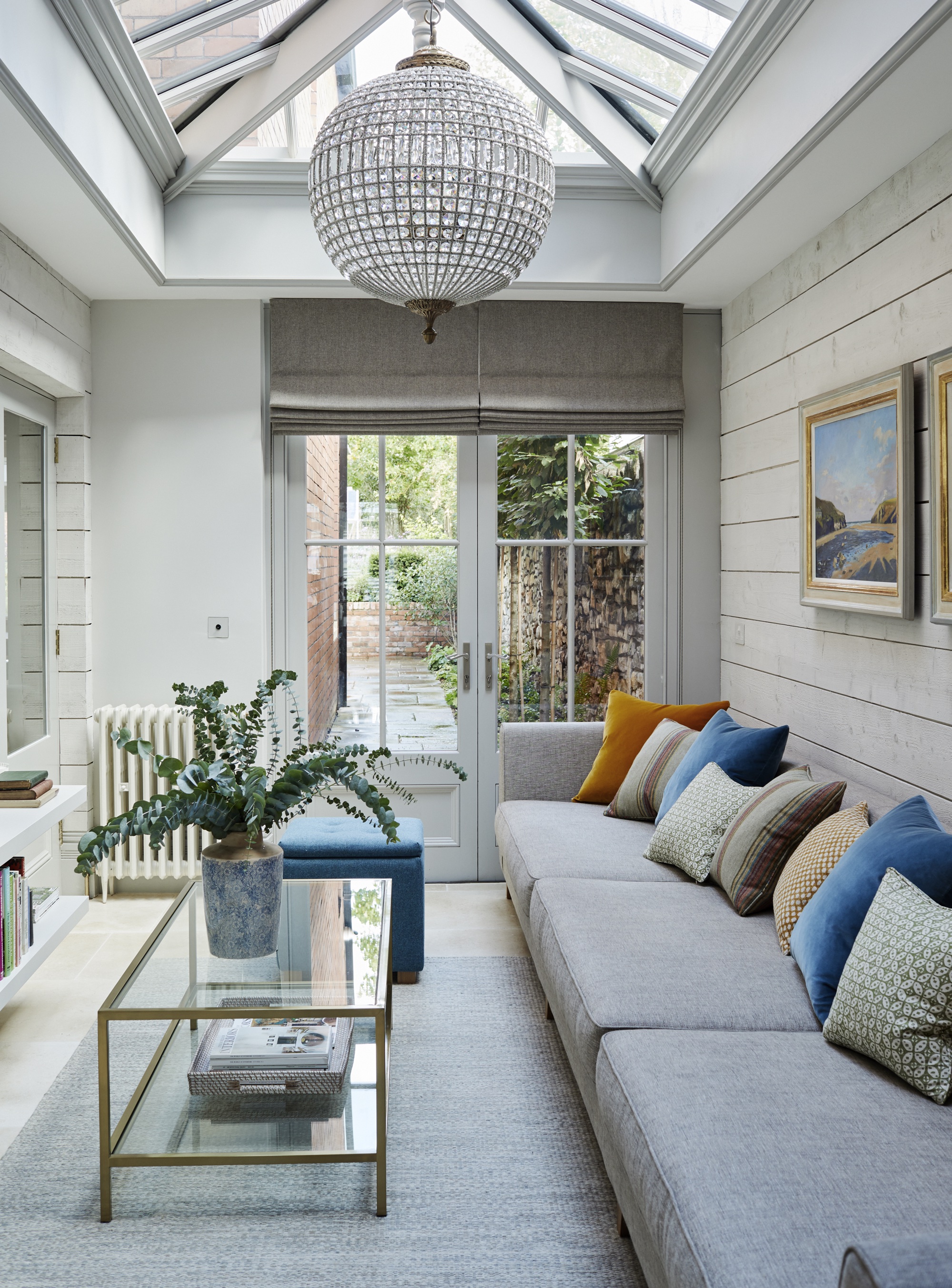
Just because your orangery is short on space doesn't mean it can't be big on style.
This perfectly petite space by Sims Hilditch, is given extra wow-factor with a glamorous chandelier pendant. It adds an element of luxury to the otherwise modern rustic living room, which is warm and inviting with lovely linens and wood-clad walls.
9. Breathe life into an orangery with bright colors
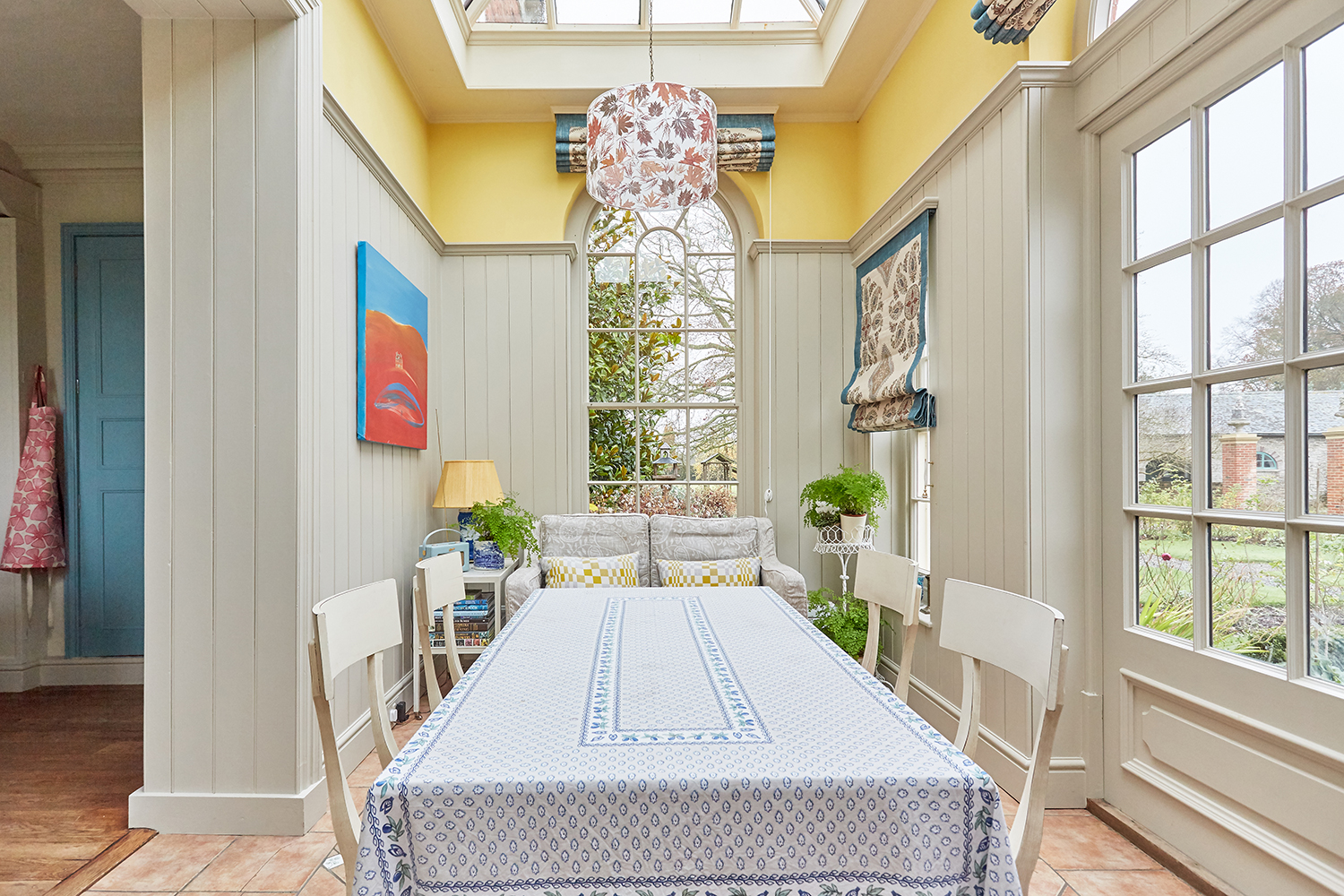
If you love a splash of colour throughout your home, don't be shy about introducing it into your orangery, too.
'I love the coluors of sun and sky together in this orangery kitchen,' says Edward Bulmer. 'A pop of yellow will brighten any room and our lovely Brimstone is full to the brim with sunshine. Here, it also gives height to the room. Both the yellow and blue are subtly reflected in the curtain fabric (Peter Dunham textiles from Tissus D’Helene trimmed with a plain from Fermoie).
'The wall colour is Dove so just a gentle neutral backdrop for all the other colors to shine from.'
10. Enjoy a modern-industrial edge with black framing
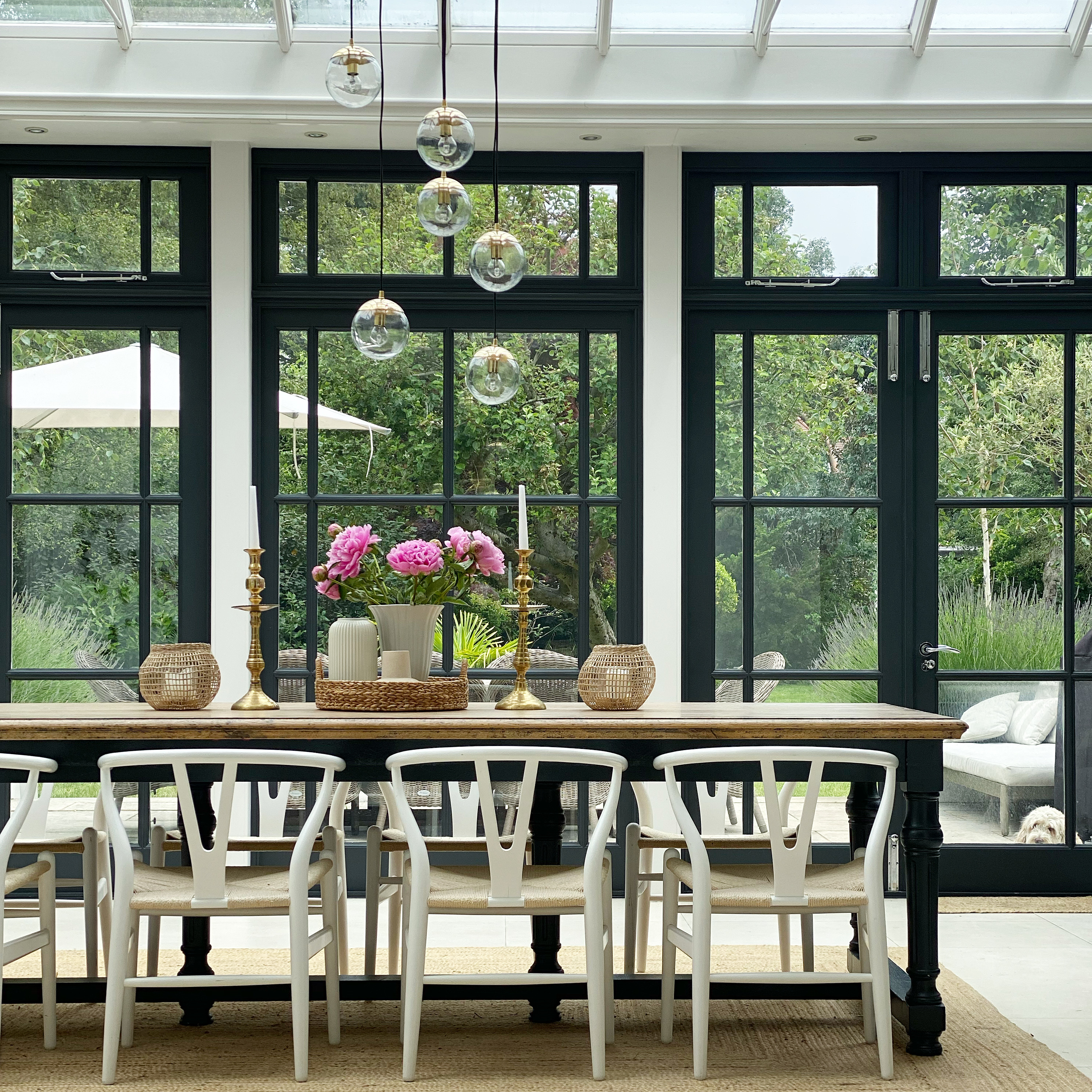
'Our orangery dining room is the heart of the home for us,' says Leoma of @styletheclutter. 'This space is north facing but, due to the glass ceiling, it is always bright and light.
'Painting the window and door frames dark has framed the garden beautifully, making all the greens from the outside pop inside, too. It has also given this space a bit more of a contemporary feel with a Crittall-style look.'
11. Hang botanical wallpaper in a bijou orangery
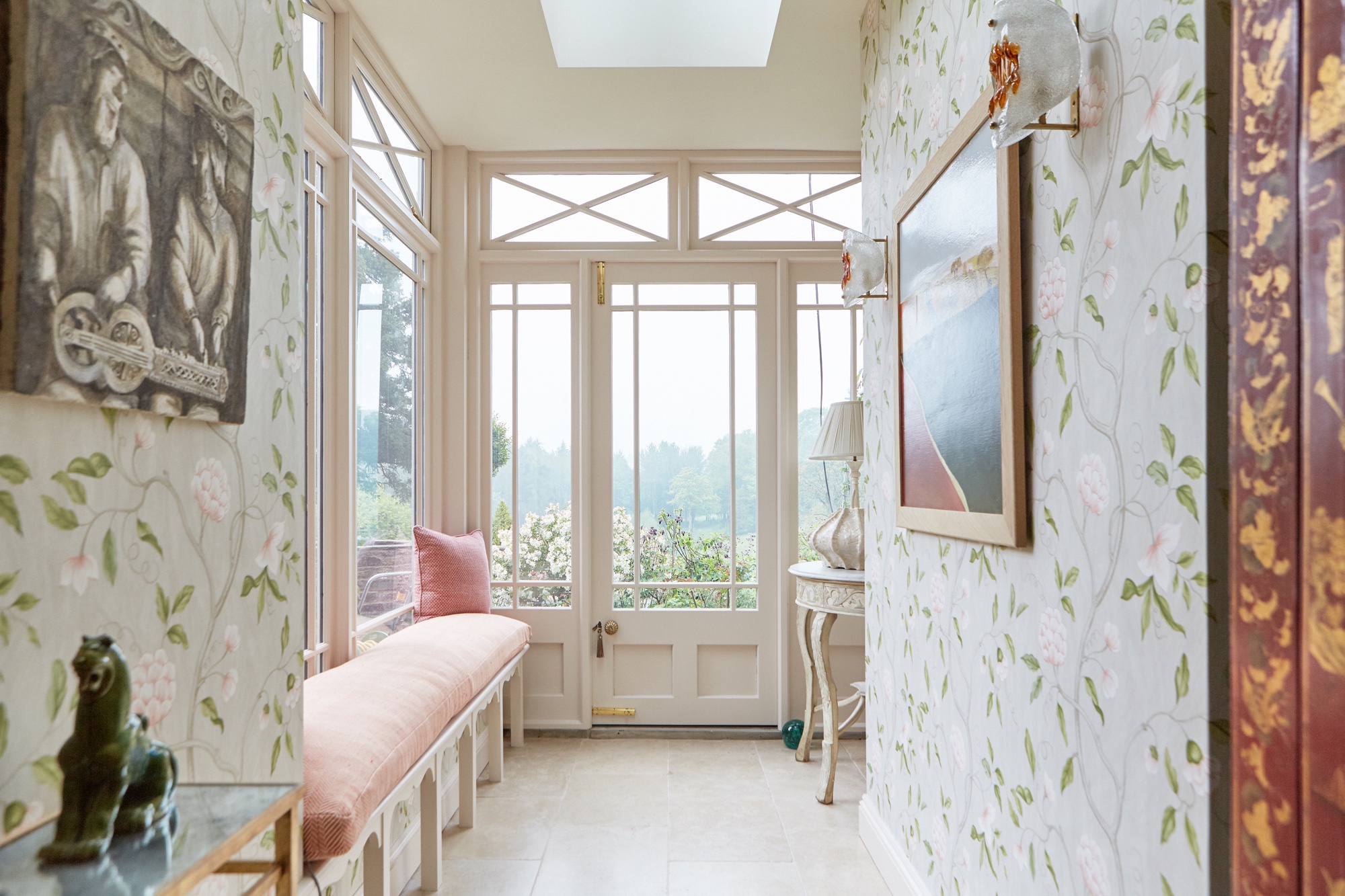
Make a small orangery even more cosy – and, of course, pretty – with a beautiful botanical wallpaper.
This lovely reading nook is enhanced with the Snow Pea or Snow Tree printed wallpaper by Colefax and Rose Tinted White Paint by Edward Bulmer.
'Pink and green are a match made in heaven as illustrated in this orangery,' says Edward Bulmer. 'The woodwork is painted the vaguest hint of pink in our Rose Tinted White just to pick up the tint in the wonderful rose arbours in the wallpaper. A very soft and romantic match indeed.'
12. Add antiques and curios for a vintage vibe
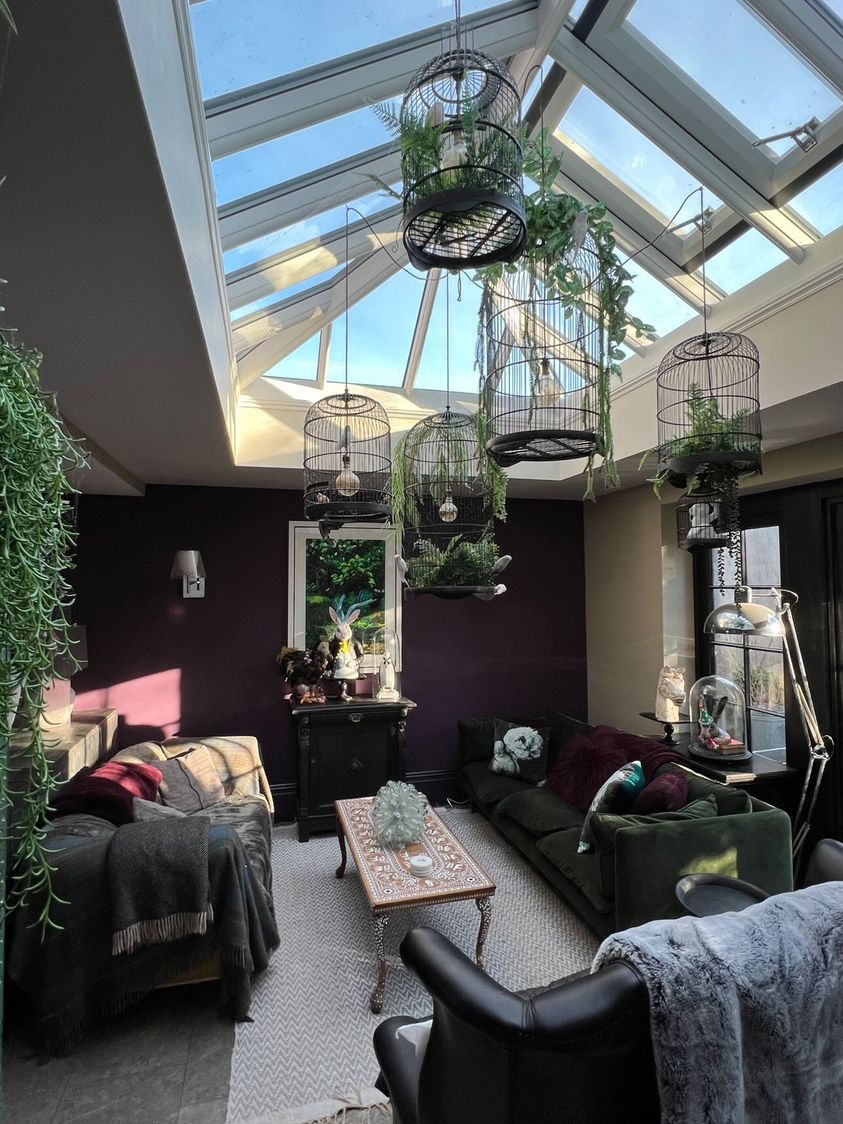
An orangery doesn't have to be old fashioned, as this cool vintage-style room proves with creative panache.
Simply add objet and curios that you might find at a flea market or in an antique store, and think outside the box with your design ideas; these birdcage lampshades are innovative and work to create an eclectic aesthetic.
'I never set out with a finished look in mind,' say @gray_finch, 'more I buy pieces that I love, a lot being antique, and (most of the time) they complement each other and add visual interest and a vintage feel to the space.'
13. Put your feet up on an ultra-chic chaise
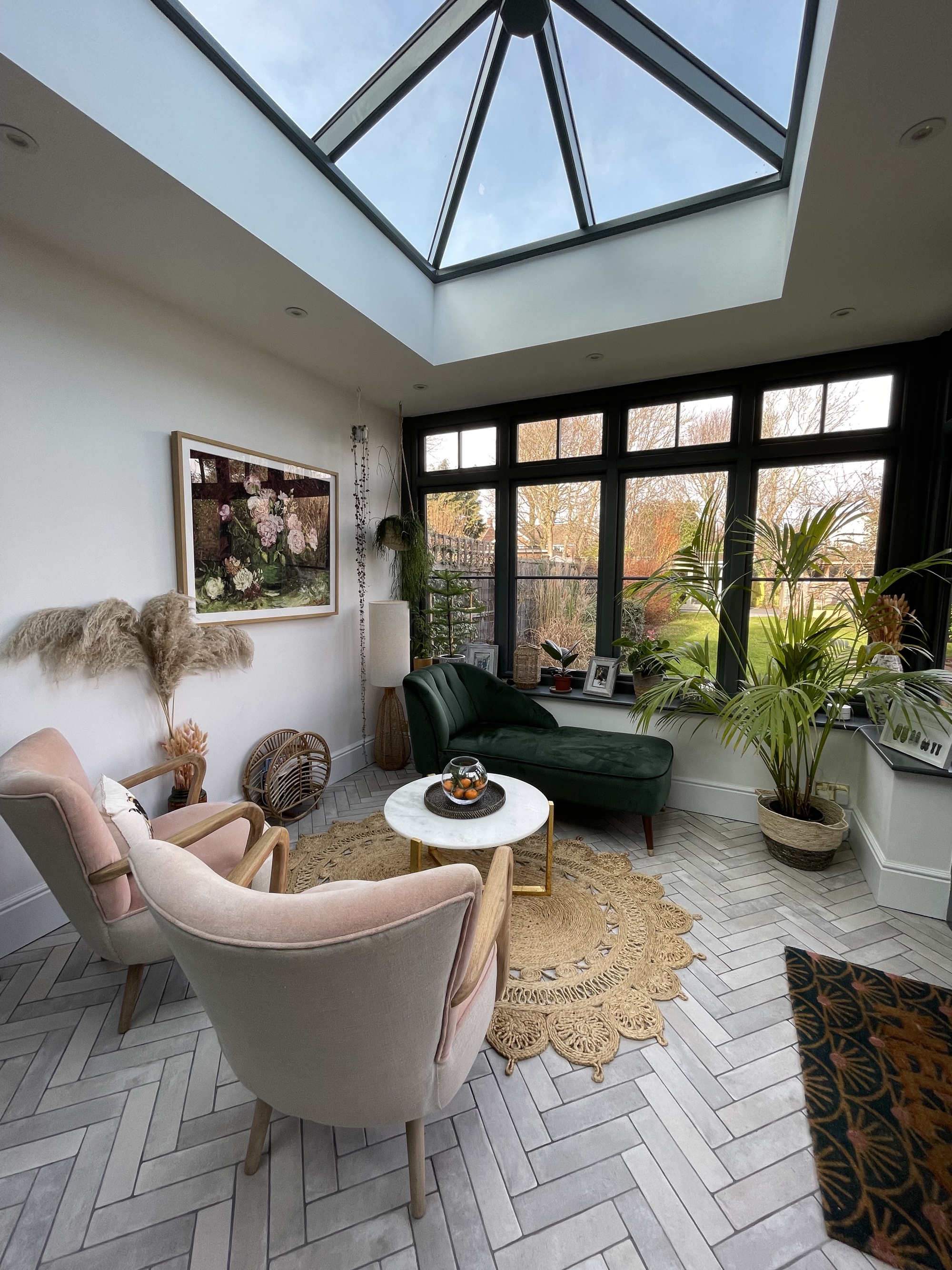
Elevate your orangery lounging with a chaise longue for an upscale look.
This beautiful space belongs to Emma of @keepingupthestyle, who says: 'We wanted it to really feel like an orangery in the traditional sense; so very bright, airy, fresh and with lots of green!
'As a result, we kept the walls minimalistic and light in terms of colour (F&B Wevet) and so to contrast against the deep grey of the woodwork, which was a color match to F&B Downpipe.
The flooring was the toughest decision as, again, we wanted it to have that traditional orangery feel; they are a handmade, light grey Italian porcelain tile and each one is different, giving that rustic, natural look we were after. We chose a dark grout colour, not only to contrast against the light grey but also for practical purposes with two young children.
Styling-wise, the orangery has a mix of materials, textures, and colors. There's some marble, jute, suede, rich walnut wood, brass, and various colors for the seating but it seems to work. And, to make it feel like a traditional orangery, there are a lot of plants. The green really connects the outside to the inside.'
14. Take inspiration from design-driven hotel orangeries
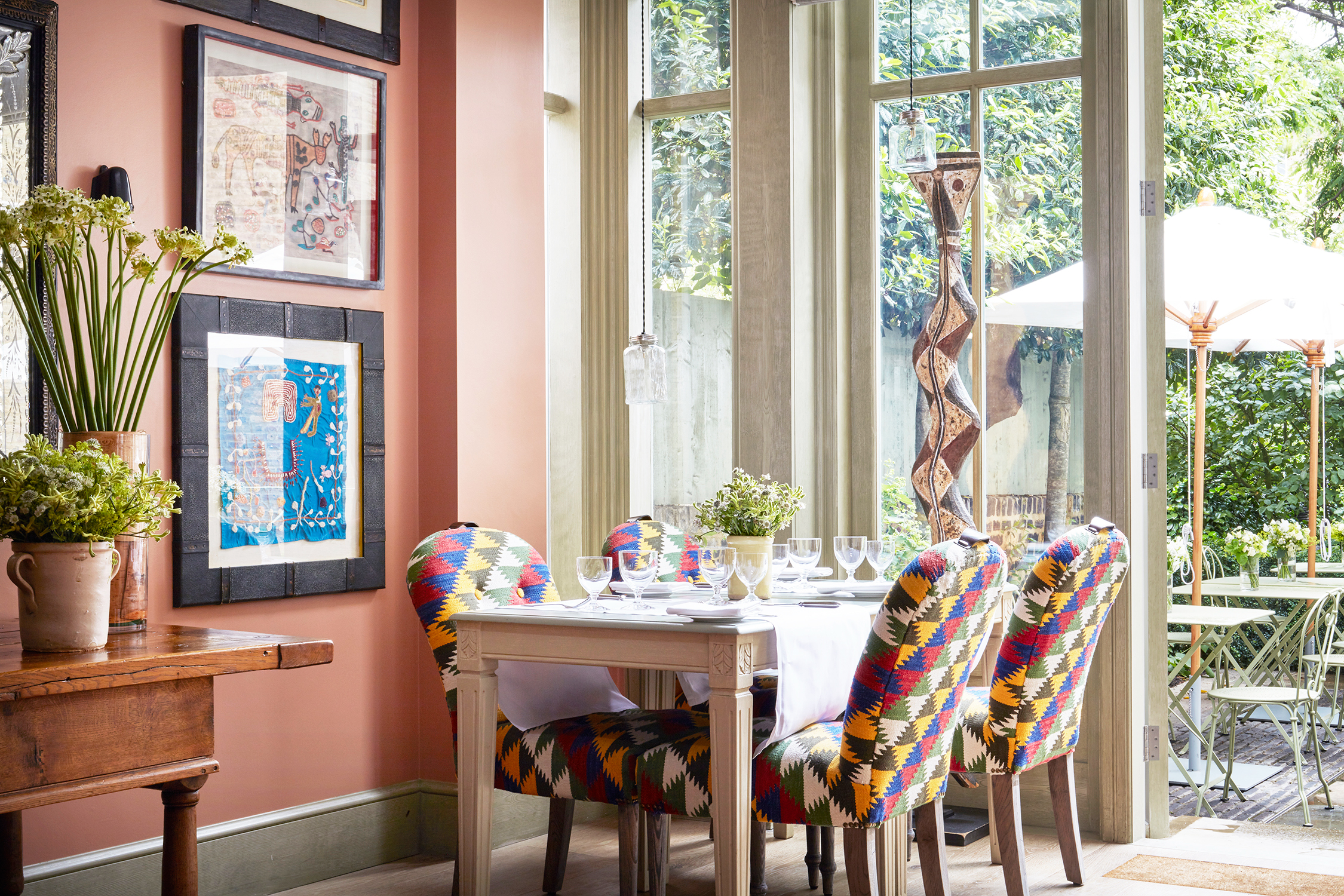
If you want to embrace color and art but need a little nudge in the right direction, look to design hotels to see how it's done.
Over at Firmdale Hotels' Number Sixteen in London, there's a stunning yet cosy and informal orangery that celebrates natural hues with a bold twist.
Designer Kit Kemp says: 'We wanted this room to actually reflect the garden. There should be a vividness and light about it, so the colours work very well, and the two work together in harmony.
'The artworks are actually pieces we've collected over the years, and three of them are Aboriginal.'
They add a sense of character to the space, as well as a high-end curated feel. If you want to add some print but don't know where to start, take inspiration from the room and try bright upholstery on your dining chairs.
15. Embrace natural materials for a serene space
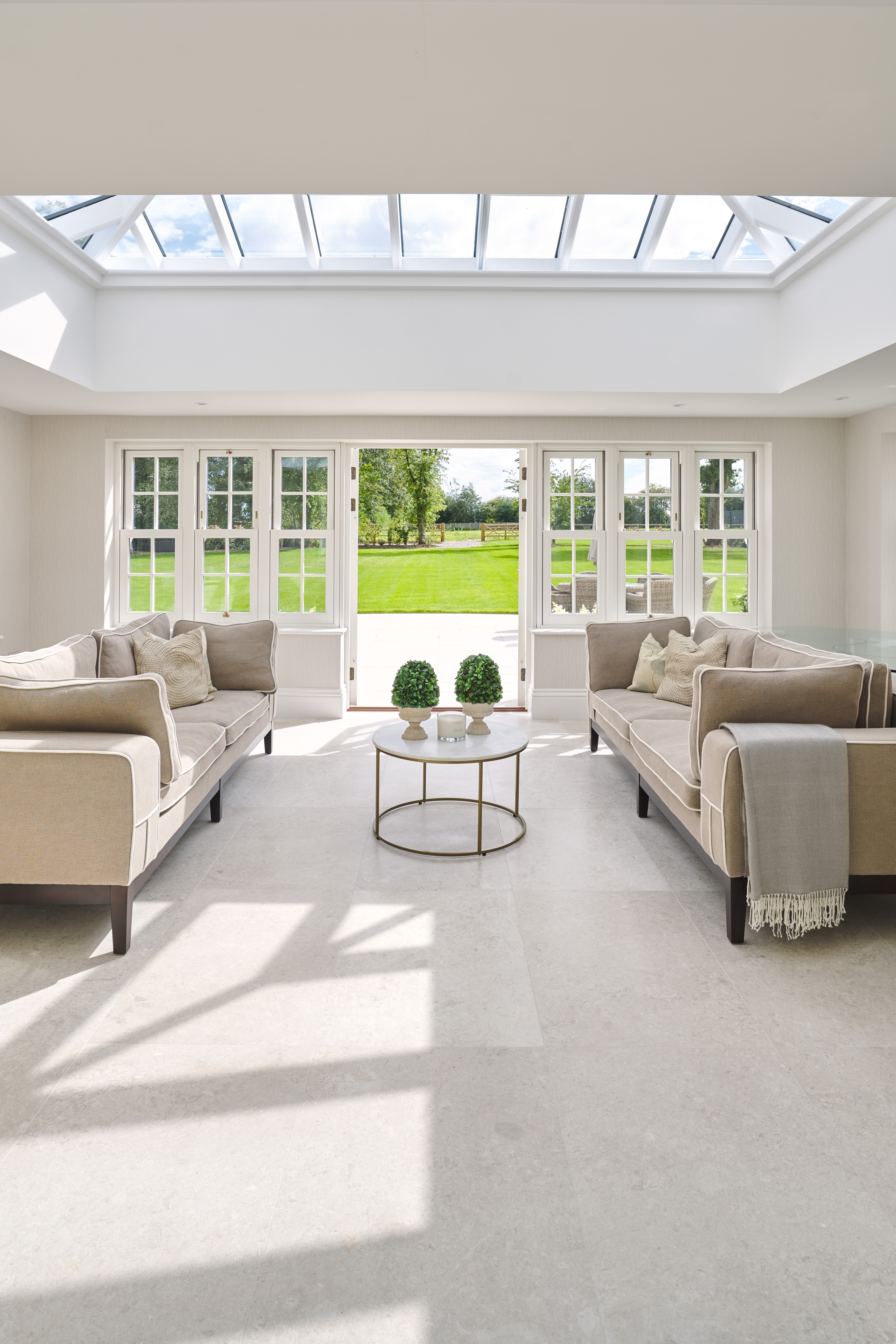
Investing in natural stone will elevate a room and add a timeless touch to your project.
Hamish Smith, creative director of Artisans of Devizes, says: 'The beauty of natural stone is that it becomes lived-in and ages beautifully. If you are looking for something truly timeless then natural stone is a great choice.'
16. Go green for a timeless yet trendy color choice
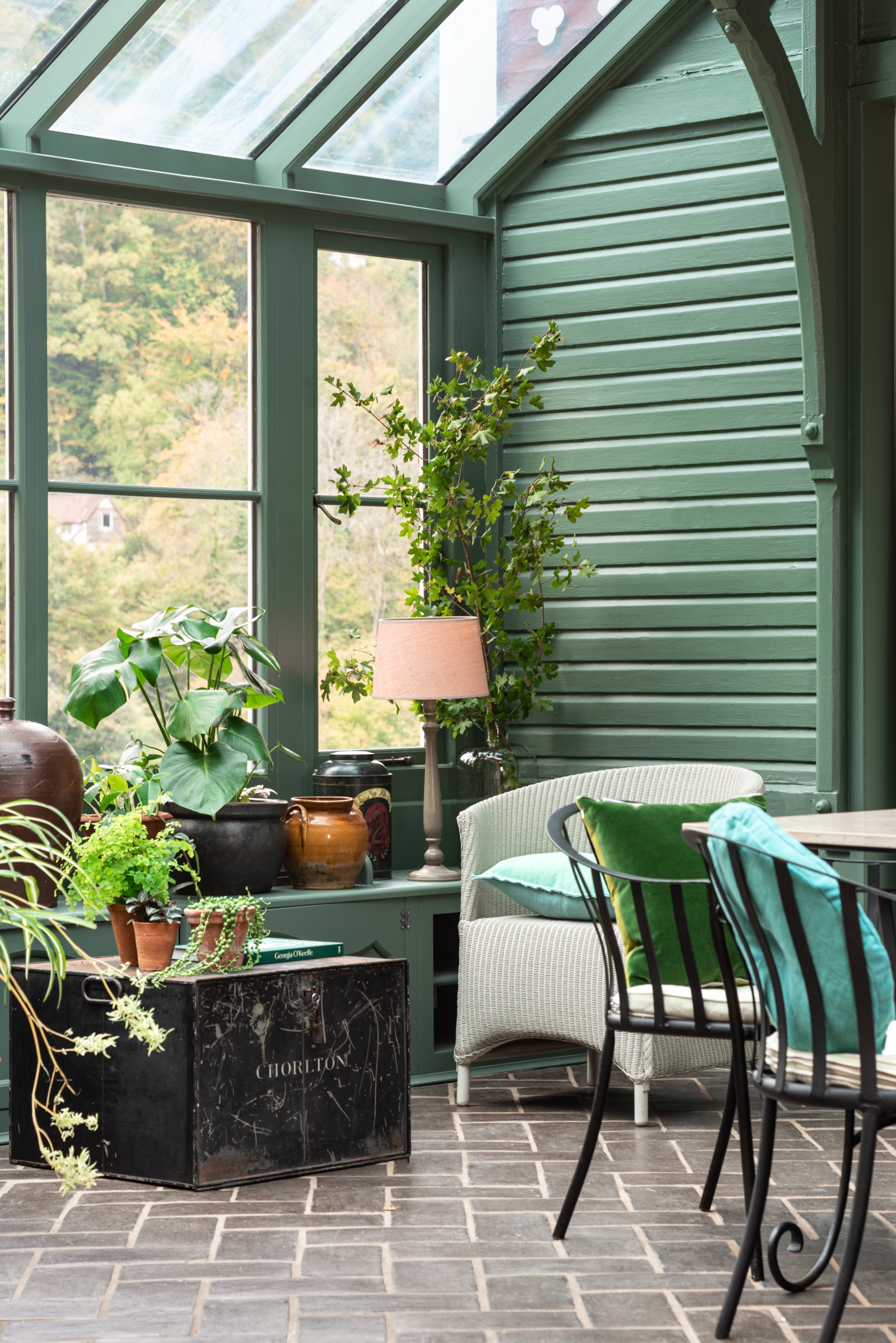
'When choosing a colour for the interior of an orangery or garden room, think about the journey from the room it leads off and how you want it to connect to the outside space,' says Charlotte Cosby, Farrow & Ball Head of Creative.
'This room, in particular, is surrounded by woodland, and we wanted to immerse the space into the trees by using Green Smoke.
'It has an irresistibly inviting deepness and weathered familiarity when used in exterior situations while evoking calm and serenity inside, so it combined the perfect combination.'
17. Choose a soothing color combination of sage green and cream
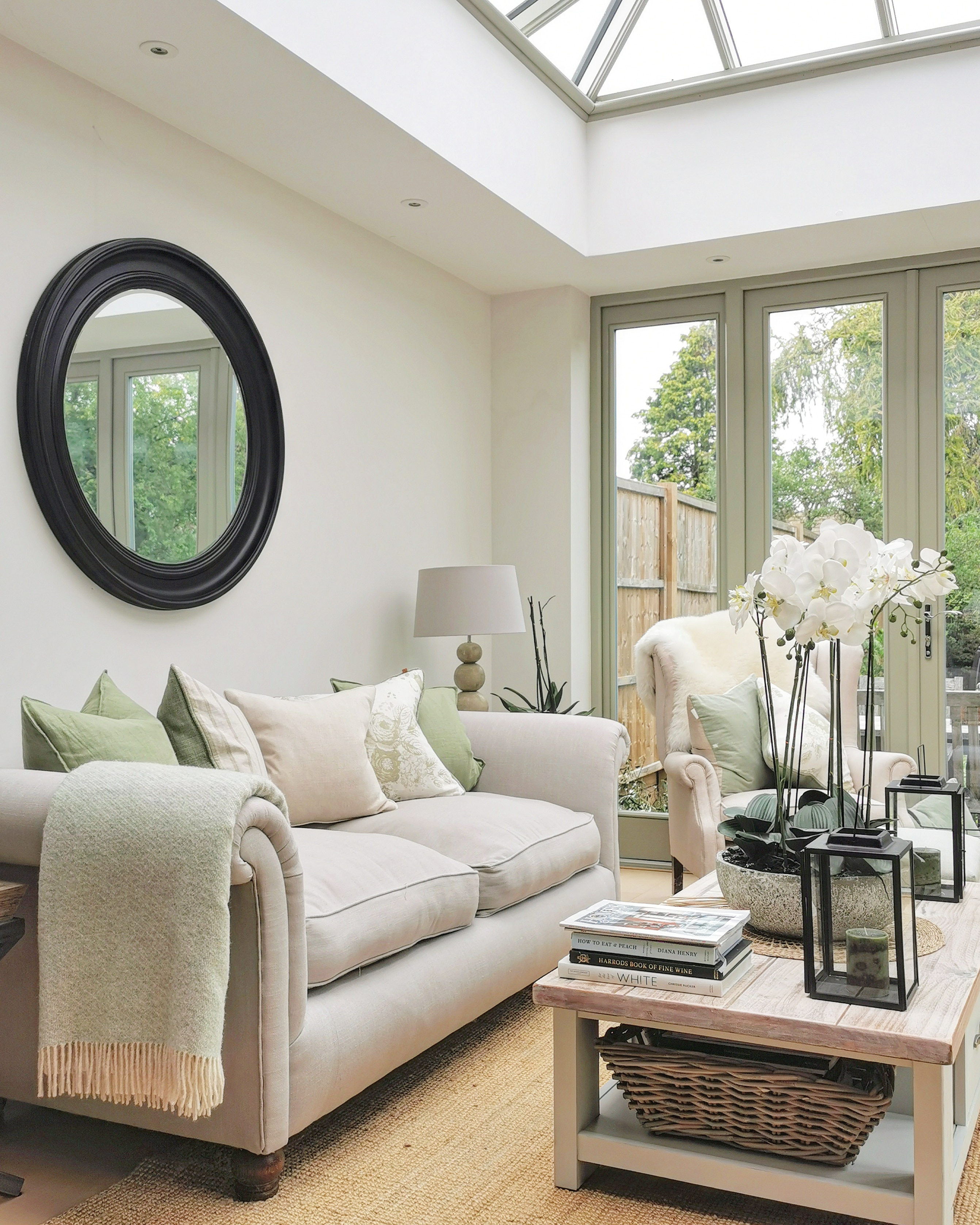
This elegant orangery idea gives a nod to contemporary country chic, and is the favourite room in the owner's house.
The decor is a beautifully soft mix of sage green and cream, which creates a calming atmosphere when mixed with other natural elements like jute rugs, wicker baskets, and bleached-out rustic timber. The matte-black accessories add a modern edge.
Angela of @orchidsandme explains how she approached the project, saying: 'I did a bit of research on bespoke orangery companies and then decided to use an architectural technician to do the drawings of an orangery designed by me.
'I then used a trusted local builder to build the shell and I splashed out on bespoke timber French doors and roof lantern to achieve the look I wanted - a space that was spacious but also cosy.'
She continues: 'Because of the muted colour scheme I think I've successfully created a calm and restful room which was definitely my aim! During lockdowns this room was my sanctuary. It is the most used room in my home: I have my morning coffee in here and when guests arrive this is the room we naturally gravitate towards as it flows from the open-plan kitchen.
'Without a doubt, the addition of the orangery has been the best decision I have made in this house.'
18. Blend traditional style with contemporary finishes
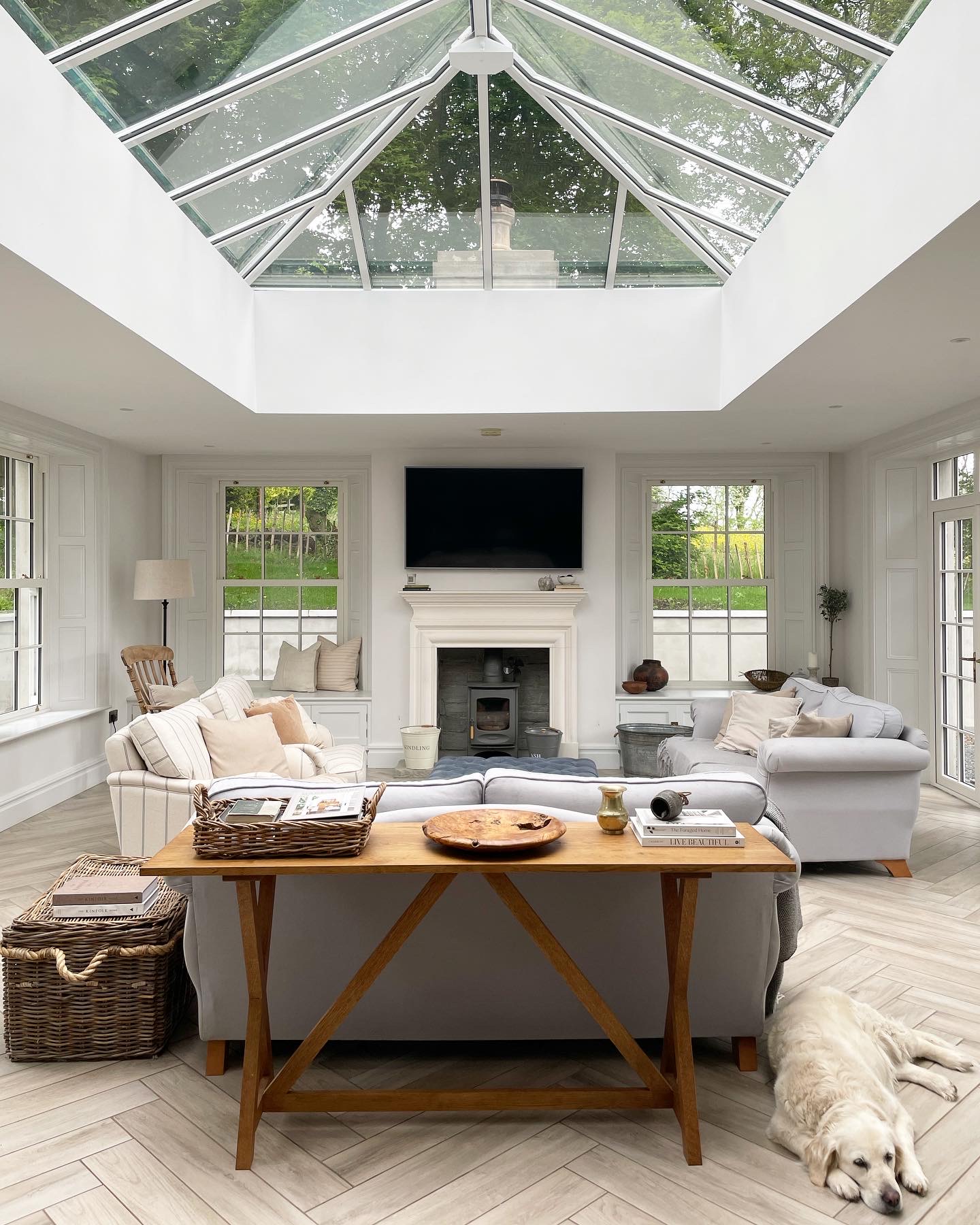
The fashion for orangeries dates back to the 17th century, so it's a traditional concept. However, your finishes can be modern and contemporary, blending the beauty of authenticity with everything a busy lifestyle needs today.
Speaking about her stylish orangery, Helen of @insidenumbersixteen, says: 'We have a large open plan orangery, in a traditional style with contemporary features.
'Our large roof lantern is 3m x 4.6m, and the space is the heart of our home. It works perfectly for family life and we are surrounded by our garden and patio, allowing for a connection to our countryside setting.'
19. Choose neutral hues for a clean-lined, calming aesthetic
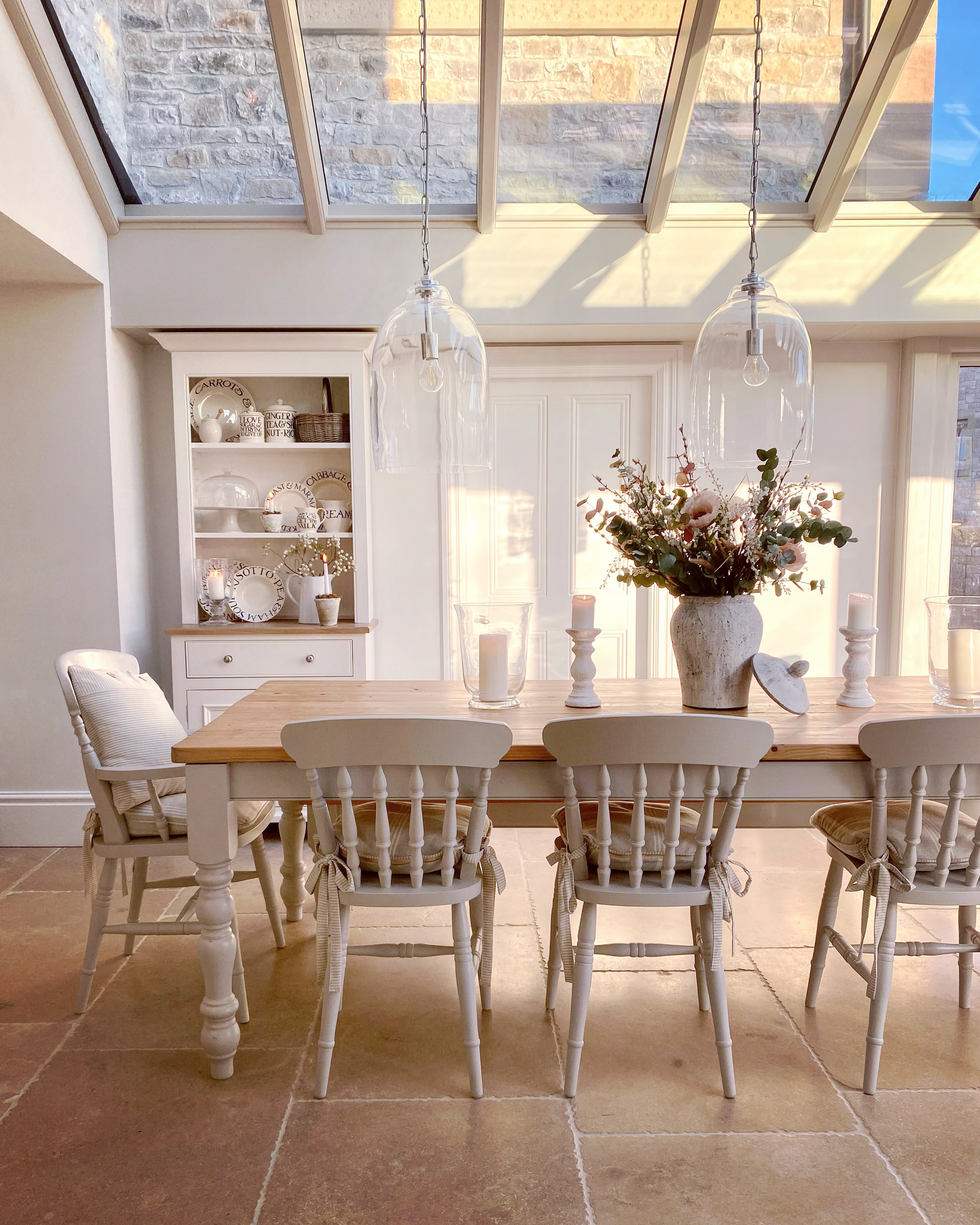
Create a restorative space as the heart of your home with an open-plan kitchen diner finished in calming creamy hues.
'We converted our standard conservatory with doors shutting it off into an open kitchen/diner space so we would use it more,' says Katy @katy.harwood.life of her tranquil space above. 'We added the special warm/cool glass so that it really keeps it nice and cool in the summer and warm in the winter.
'It works amazingly and just feels exactly the same temperature as the rest of the house, if not warmer, as we have added heated floor in here, too.
'When the sun's shining it’s the perfect place to sit and really feels like you're bringing the outside in.
'We have also added bifold glass doors to the end so we can completely open it up into the garden in the summer months.
'We designed the kitchen so that I have my island with a sink looking out towards it, which works so well and always lifts your mood from the cooking space.'
20. Opt for an orangery style that's sympathetic to your existing property
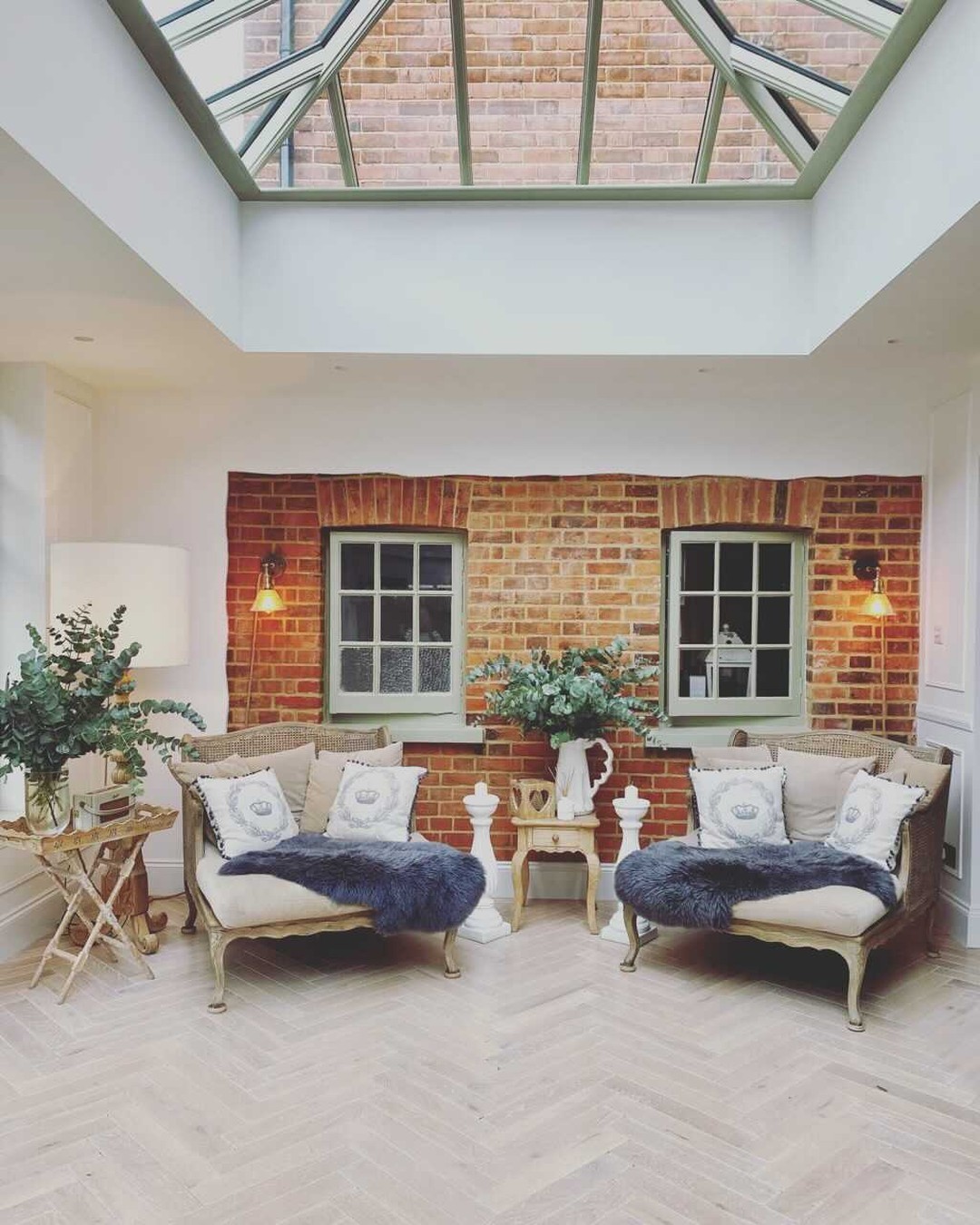
'We decided on a timber frame orangery (Lomax & Wood) as it would be sympathetic to our Edwardian home,' explains Justine @our1904home about her pretty space.
'I chose Farrow & Ball French Grey inside and out as it paired well with red brick, which is what the house is largely made from (an element of which I choose to keep exposed inside the orangery, too, which was one of the original outside walls).
'Tumbled oak herringbone floor stained in a white wash tied in the natural wood element that I mirrored in a reclaimed Edwardian fire surround at the other end of the orangery. The walls are panelled and painted in Farrow & Ball Wevet.'
Justine adds: 'For lighting, I chose Industville Brooklyn wall lamps in antique brass with fluted glass shades and chunky rope cable so the brick wall didn’t need to be channelled.
'Finally, I have a love of French-style furnishings, and these deep rattan chairs are perfect for kicking back and reading.'
What is the difference between an orangery and a conservatory?
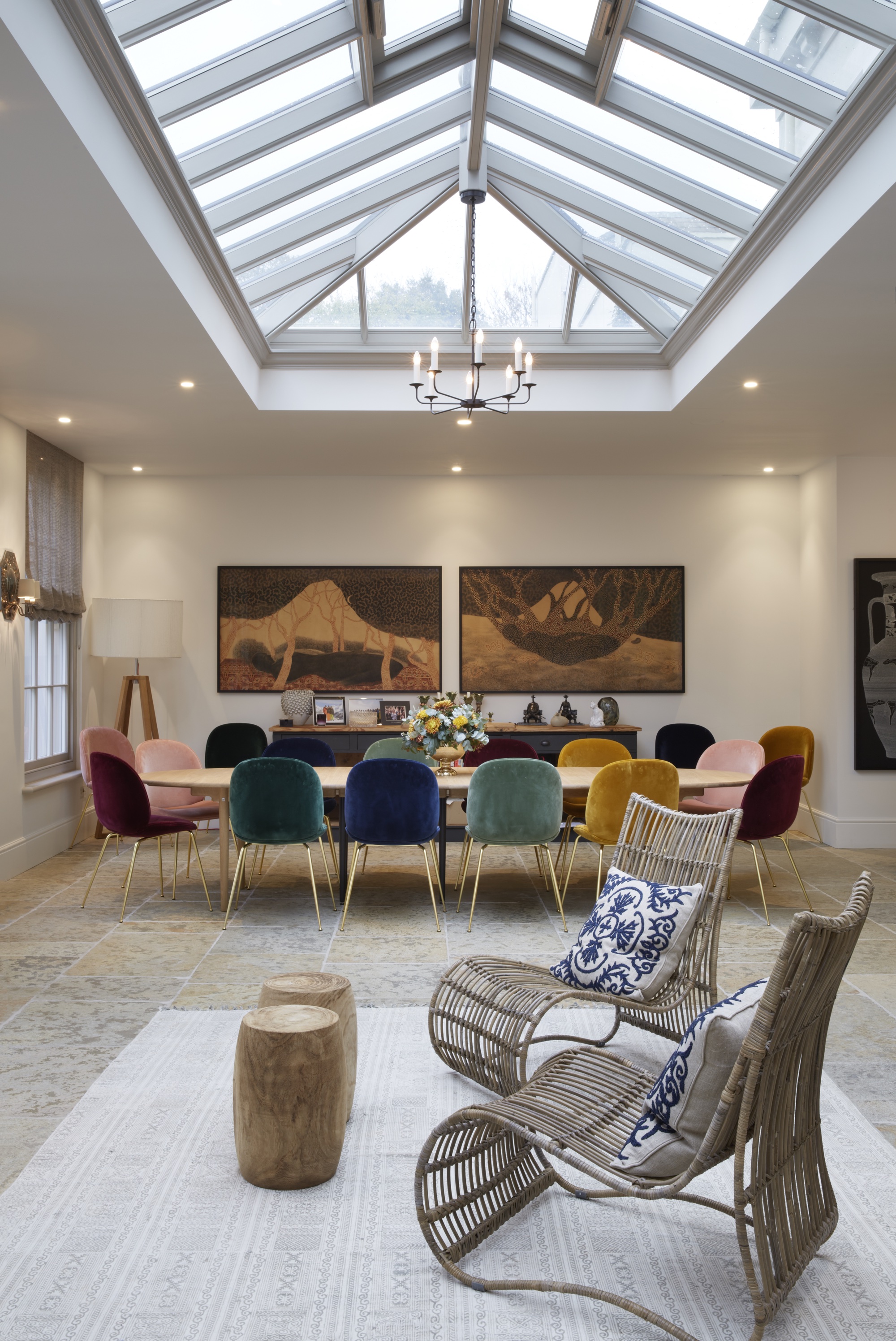
There is a distinct difference between an orangery and a conservatory, which is articulated here by David Salisbury's Karen Bell, who explains: 'The main technical difference between an orangery and a conservatory relates to how the roof of each is constructed.
'A very simple differentiation is that a conservatory has the majority of its roof glazed, whereas an orangery tends to have a solid perimeter roof with roof lanterns to allow light in. The 75% rule is often applied – more than 75% glass in the roof is a conservatory; less than 75% tends to be classed as an orangery.
Westbury's James Upton adds: 'Conservatories were a hugely popular type of glazed extension during the 1980s. Commonly associated with uPVC construction materials and rattan furniture, they will typically have fully glazed walls and a pitched glazed roof set on a brick foundation.
'The conservatory’s decline in popularity in recent years has led to a huge rise in homeowners opting for contemporary timber-framed garden rooms and orangeries. Combining balanced design with flawless functionality, a garden room or orangery extension is still the height of luxury and carries an air of sumptuous elegance.
'Orangeries and garden room extensions do not have as much glazing as a conservatory but will still create a bright and airy space,' he continues. 'Consisting of semi-glazed walls, an orangery will typically have a roof lantern built on top of a flat roof which lets the natural light stream in. Instead of feeling cold or stuffy, they are comfortable and inviting throughout the seasons, feeling cool in the summer and warm in the winter.'
How much does an orangery cost?
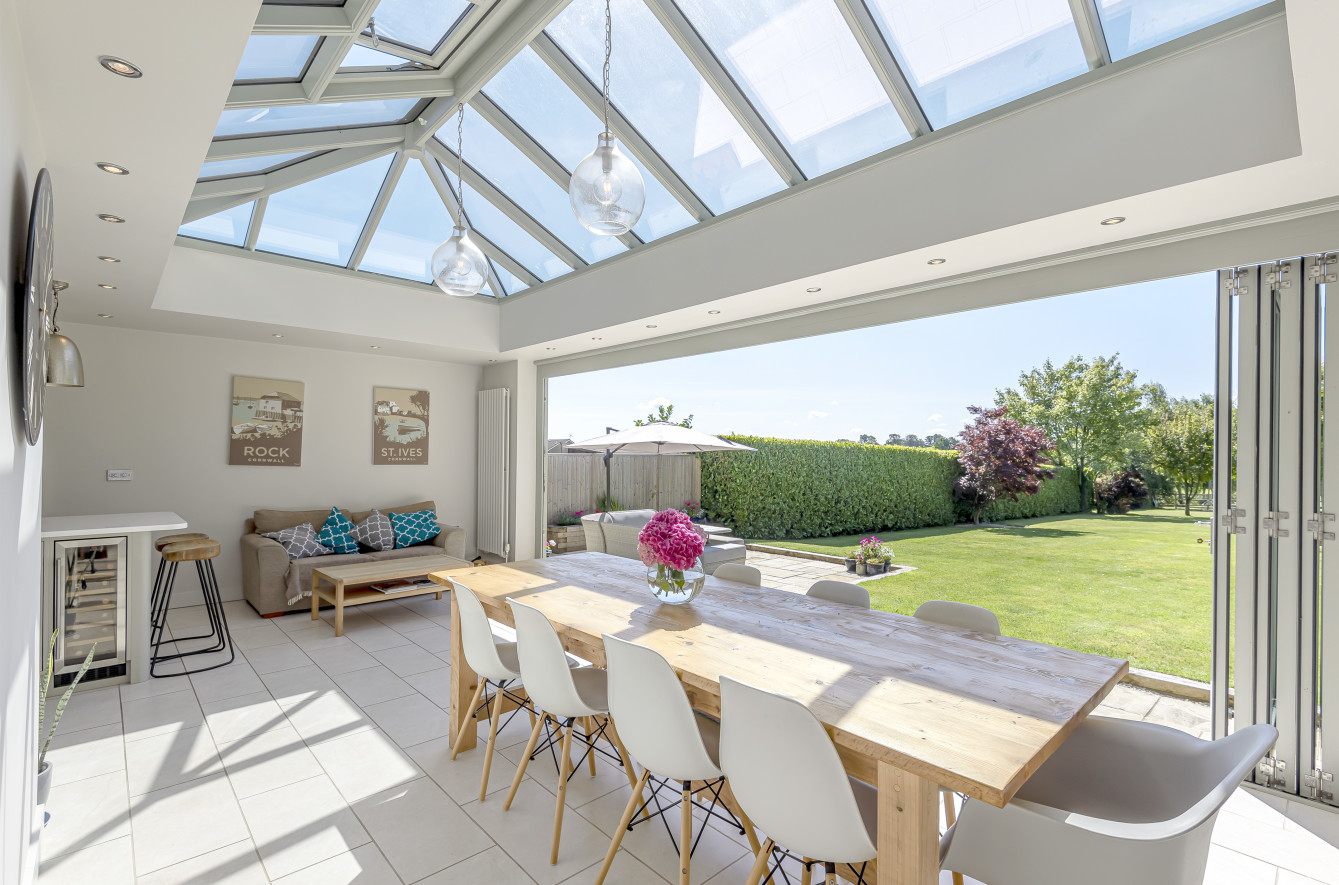
You can create a wooden orangery built from quality materials from around £40,000 (+ VAT) for the structure, say the experts at David Salisbury.
Over at Westbury Garden Rooms, prices start from £50,000. James Upton says: 'Orangeries generally cost from around £50,000 + VAT and prices largely vary due to the size of the orangery.
'The approximate average cost of a Westbury orangery is about £80,000 to £90,000 with an average size of around 35-45m2. But the total price will ultimately come down to how many sides of joinery, and various customizable options.
'As with any bespoke building project, many factors can bear an impact on price. Any number of unique or extra design points can influence the cost. But generally, the following design details can affect the price:
'You will also need to factor in the building costs when starting an orangery project as these are often not included in the price of the installation.'
If you're looking to build a large, ultra-high-end orangery, you may need to expand the budget further, says Nick Cryer, of Berkeley Place. He comments: 'On average, we would say a well-designed good quality orangery is in the region of £75k to £150k++ (excluding VAT).
'An orangery is a more substantial building than a conservatory for instance, so a more substantial foundation is necessary. Costs mirror those associated with a single-storey property extension.'
Do you need planning permission to build an orangery?
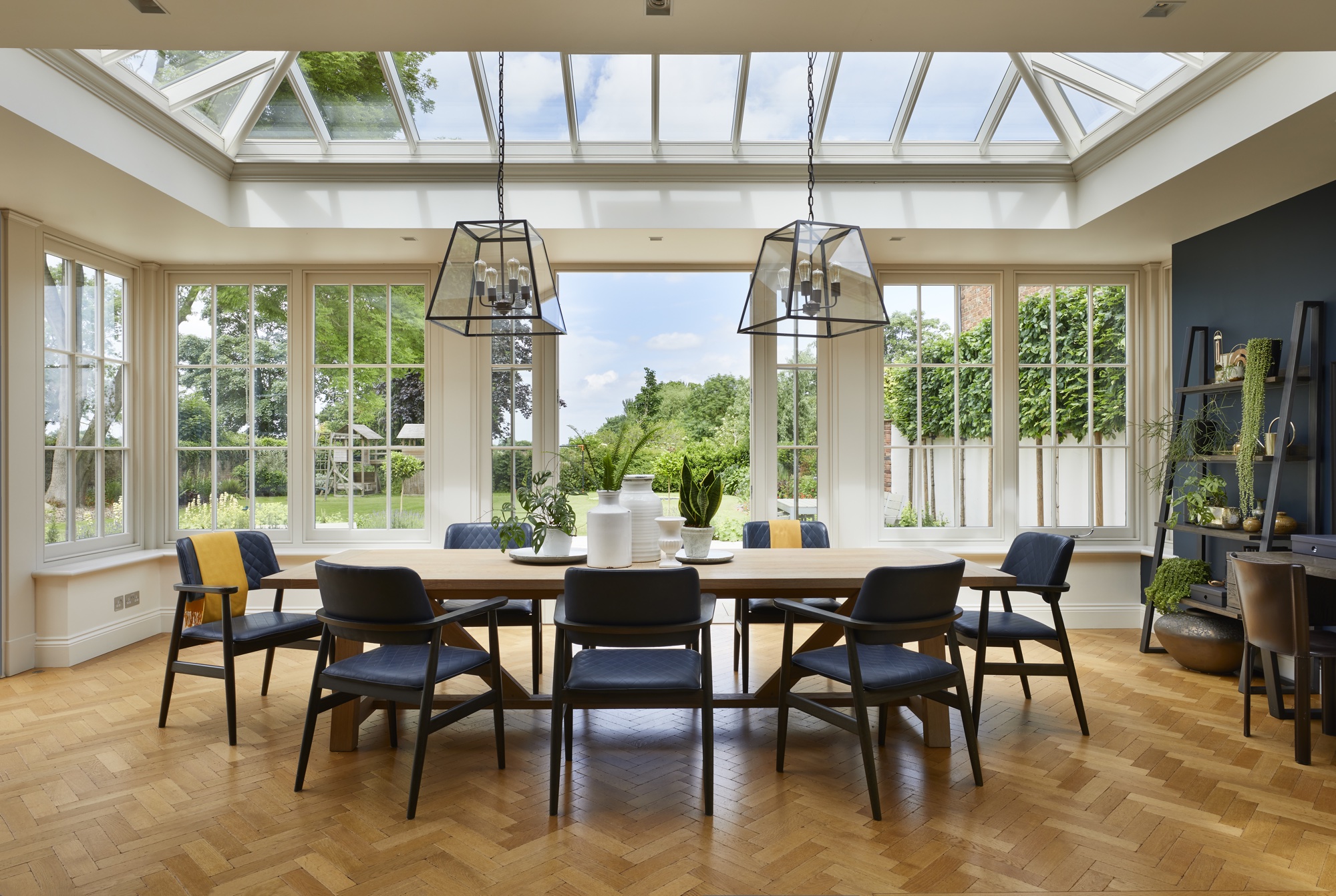
'Depending on your type of property and location (there can be exemptions for listed properties and those situated in AONB and National Parks), most smaller sized orangeries do not require full planning permission and can be built under the concept of ‘permitted development',' explains Karen Bell.
'However, any orangery of a reasonable size is likely to require planning permission – some orangery companies will offer to handle the planning application on behalf of the client, so this is a question worth asking when considering a potential supplier.'
James Upton elaborates, explaining: ''If you don’t want to have to apply for planning permission, then the first port of call is to check your area to see what the local planning implications might be and to see if your home has permitted development rights.
'Permitted development rights are an established grant that a house might already have in place allowing some building works to be undertaken without having to make an application for formal planning permission, as you would with a loft conversion or a new porch.
'In the UK, changes were made to permitted development rights on the 30 May 2019, larger rear extensions are now allowed but do require prior notification in the form of a lawful development certificate (LDC) – going up to 8m in depth for a detached house and 6m in depth for a semi-detached house.'
For more information on UK planning permission regulations visit the UK Government website.
Will an orangery add value to your home?

'An orangery from a quality supplier will add a luxurious extension to a home, simultaneously adding space, and are proven to add value,' says David Salisbury's Karen Bell. 'Modern orangeries are designed to be used enjoyed all year round – most customers tell us they become the favorite room at home.'
Haddonstone's Nicola Clements comments: 'Just like adding an extension to your home, a high-quality orangery can add significant value to your property. In some cases, it can increase the value of your home by as much as a typical bricks and mortar extension. Whilst the cost of adding an orangery isn’t cheap, the practicality and long-term value of owning an orangery will outweigh the costs.
'As a rough guide, a quality conservatory costing up to £10,000 could increase the value of your property by up to 10%. So, adding a more ‘statement’ extension like an orangery will likely outperform this significantly.'
And James Upton, of Westbury Garden Rooms, says, 'The materials used to build an orangery also impact its value but are often overlooked. Components such as a stable and durable timber (like Accoya), solar-controlled glass, micro-porous paints and powder-coated aluminum on the roof will not only look good, but will also be easy to maintain.'
Ruth Doherty is a lifestyle journalist based in London. An experienced freelance digital writer and editor, she is known for covering everything from travel and interiors to fashion and beauty. She regularly contributes to Livingetc, Ideal Home and Homes & Gardens, as well as titles like Prima and Red. Outside of work, her biggest loves are endless cups of tea, almond croissants, shopping for clothes she doesn’t need, and booking holidays she does.